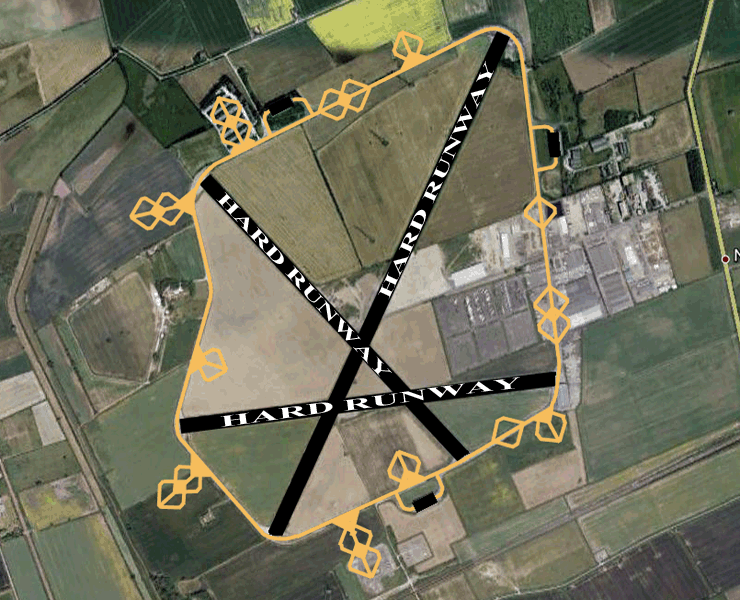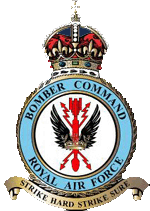North Killingholme Airfield History

(Map edited to show the airfield and runways between 1940-45)

© Crown Copyright/MOD 2010
53° 38'9.7"N 0° 17'30.9"WRunways: 09/27 & 15/33 4200ft x 150ft - 04/22 6000ft x 150ft
Construction of the airfield at North Killingholme started on 23rd September 1942. The site chosen is just west of the village, and was built just one mile from the site of the First World War seaplane base used in 1918 by the US Navy. The contract for the Class A airfield was given to John Laing & Son and was worth £810,00.
The layout for the airfield was to be for 36 loop type hardstandings. A T2 hangar was to be built by the technical site, south of runway head 22. The second T2 hangar was to built on the south-west side of the airfield, between the runways heads of 04 and 33. The third hangar (which was to be built at a later date) was to be a B2 type. This hangar was built for use by the Ministry of Aircraft Production contractor engineer’s.
The bomb stores were built close to Skitter Beck, between the runway heads of 15 and 09. The station itself consisted of a single mess, communal, WAAF site, six domestic and sick quarters. In total the station was capable of catering for 1939 male personnel and 325 female personnel.
RAF North Killingholme was finally opened on 17th November 1943, under the control of 1 Group, Bomber Command. At the turn of the year, on the 1st January 1944, the station was absorbed as a sub-station of 13 Base which had been formed the same day.
Although the station was ready to receive its first squadron by the 1st December 1943, they did not arrive until the 3rd January 1944, and it came in the form of No.550 Squadron. By the 12th September 1944, the squadron had bulked up to three flights and contained some thirty Avro Lancasters.

© No.550 Sqn Association - No.550 Sqn - March 1944
During the squadrons brief spell at the airfield it became one of the most successful squadrons in the RAF in terms of its success efficiency. Along with this success, it was also chosen to trial the maximum fuel load and bombs a Lancaster could take-off with. It was reported that the weight was so great at times that the wings on the aircraft could be seen flexing as they took off.
A No.550 Sqn Lancaster (LL811 J-Jig ‘Bad Penny III’) was also to be the first aircraft to drop its payload to mark the start of the assault on the Normandy beaches. The crew of the Lancaster were to be later awarded the Croix de Guerre by the French for its role in Operation ‘Overlord’.
During the squadrons first twelve months at the station it amassed a total of 11,748 tons of bombs dropped. The pace continued, and in March 1945 they had amassed 1,534 tons for the month, an all-time record during the war for a Bomber Command squadron.

© No.550 Sqn Association - No.550 Sqn Bomb Aimers - May 1945
The squadron’s last act of WWII was to supply food to the Dutch and assist in the repatriation of ex-POW’s before they were finally disbanded on 31st October 1945 whilst still at North Killingholme. During the war, no less than three of the squadrons Lancasters had completed a very impressive 100 operational missions each. BQ-F ‘Press on Regardless’ ED905, BQ-V ‘The Vulture Strikes’ PA995 and BQ-B ‘Phantom of the Ruhr’ EE139. The best known of these three planes is the EE139 “Phantom of the Ruhr” which clocked up a total of 121 operations. Although Lancaster PA995 was the only aircraft of the three to do all 100 missions while based at North Killingholme.
No.550 flew some 192 bombing raids with 58 Lancaster's failing to return and another four destroyed in crashes during the war. In total they flew an impressive 3,582 operational sorties while stationed at North Killingholme.
Just before the end of the war the airfield was to see a new arrival in the form 1 Group Bomb Handling School in April 1945. Their stay here was short lived though, and by October the same year they had gone, and with this the station was officially closed on 31st October 1945.
With the end of WWII, the station administration was passed over to Hemswell and the airfield was placed on Care and Maintenance until January 1946. With this, 35 MU used the airfield as a sub-site for external storage.
Slowly over the coming years RAF North Killingholme was sold off, until in 1965 the entire airfield had been sold. The majority of the land was returned back to agricultural use, but the runways were left pretty much untouched. By now the majority of the buildings had fallen in to disrepair, and some had totally crumbled away. But even with the state of the disused airfield new life was to be breathed in to her again.
Even with the sale of the entire airfield there was still life left in her yet. Many of the buildings were taken over for light industry and storage, mostly associated with the nearby port of Immingham, and the runways provide container parks and also support poultry houses. The remaining hangars were also put to good use, and used for warehouse storage.

© Richard Flagg - T2 Hangar 2008
Early 1981 saw the location being considered by car giants Nissan as a possible location for a new car plant, but this deal was to later fall through.
A memorial was finally erected on 31st July 1982 dedicated to the memory of all the personnel of No.550 Sqn that never returned to the once proud station. The memorial is located just off Church Lane in the village.
Today the airfield has grown in to a thriving industrial estate, culminating in the main approach road being named ‘Lancaster Way’, as a mark of respect to its heritage. The remaining hangars are still in use for warehousing and the runways are still pretty much intact and used for open air storage. A large part of the site houses a large depot for Volvo construction equipment, amongst other companies currently residing at the former airfield.
| Date | Squadron | Notes |
|---|---|---|
| November 1943 | Station opened. | |
| January 1944 | No.550 Sqn | Operating Avro Lancasters. The squadron disbanded on 31st October 1945. |
| April 1945 | 1 Group Bomb Handling School | |
| October 1945 | Station closed. | |
| January 1946 | No.35 MU | No.35 Maintenance Unit used the station as a sub-site for external storage. They left in September 1950. |
| December 1950 | RAF North Killingholme closed it's gates for the last time. |
